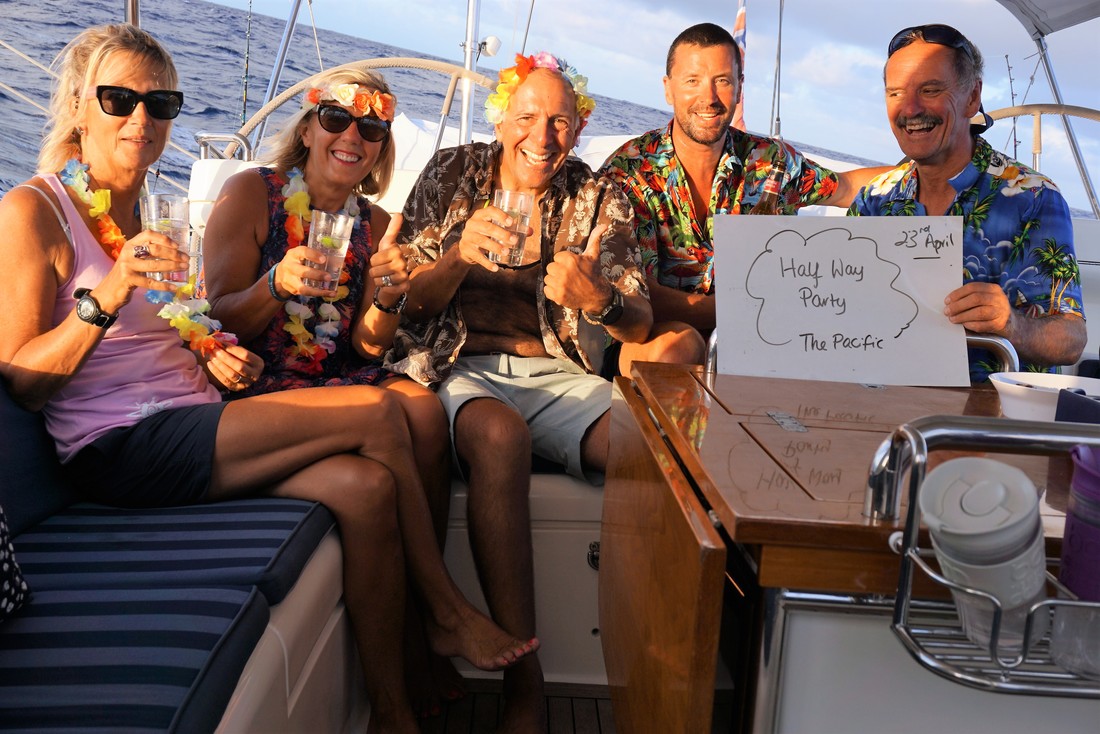|
So we're now over half way on our journey from The Galapagos to The Marquesas, the most Easterly of the French Polynesian Islands. In total a passage of just over 3000 miles and 18 days across the Pacific Ocean. We've had good winds and are bowling along at about 9 knots with a poled out genoa (for the sailors amongst you). We get asked a lot whether long passages are boring...weirdly enough they aren't. The first few days take a bit of settling in and everyone is a bit quiet and sleepy/grumpy as they get used to the motion of the boat and the night watches but once you're in the groove there is a gentle rhythm to the day and you'd be surprised how quickly the time goes. We fill the day with a host of activities - boat checks, reading, cooking (at a 40 degree angle), podcasts, films, crosswords, drawing (Hugh - after we confiscated his guitar), passage planning (Andy - he loves maps), exercises, night watches, Desert Island Discs and of course the obligatory daily sundowner. There's also the daily radio calls with the other Oyster World Rally yachts where news and updates are shared...from weather and fishing reports to how to fix a watermaker!
Added to all that it's just wonderful being out on the ocean, contemplating life with beautiful sunrises and sunsets. That all said we're really looking forward to reaching the Marquesas, a remote group of islands known for their dramatic landscapes- waterfalls, canyons and towering cliffs. Lots of exploring to do after our sedentary few weeks.
0 Comments
Leaving Panamanian waters it was apparent this was the beginning of a step change where wildlife was now in charge. We sailed through dolphins, rays, sharks and then a mid ocean meeting of enormous numbers of pelicans floating on the surface and spontaneously dive bombing for fish. Our tranquil route took us across the equator and transformation from 'Pollywog' to 'Shellback' honouring Neptune in a line-crossing ceremony at 10.30pm. Naturally the costume theme was Bunnies?!?!?! Hugh (Hefner) conducted proceedings with an original ode. Embarrassing photo includes new crew member Mike, on board for the leg to French Polynesia . Arrival in Galapagos was to the easternmost island San Cristobal and Charles Darwin's first stop in 1835. Wildlife in Galapagos is oblivious to humans affording you with the most wonderful and entrancing closeups. Sea lions own the port lying on the pier, benches, sun beds and our boat decks if we forgot to tie the fenders across the transom. On a hike to a volcanic lava field the black iguanas basked in the sun blocking the path. Natural Selection became clearer on subsequent islands as the iguanas were either green and red, scrawny and sand coloured or portly and sand coloured depending on the land colour and quality of vegetation. Marine iguanas can stay under water for an hour in order to cool down. Land iguanas were climbing trees! Then came the glorious birds. Our travels through the islands found us one metre away from serene Wave Albatross, male Frigate birds plumping their enormous red breasts and flapping their wings to attract a mate and the stylishly coloured Blue Footed Boobies hatching their eggs. And of course, you can't say Galapagos without thinking tortoise and they were majestic and humongous yet as if from a pre-historic time. The Americans have the only word to describe The Galapagos...awesome! Next adventure a 20+ day passage to The Marquesas! |
The Meteorite Crew
Debbie, Hugh, Janice and Andy Archives
February 2019
Categories
|

 RSS Feed
RSS Feed
